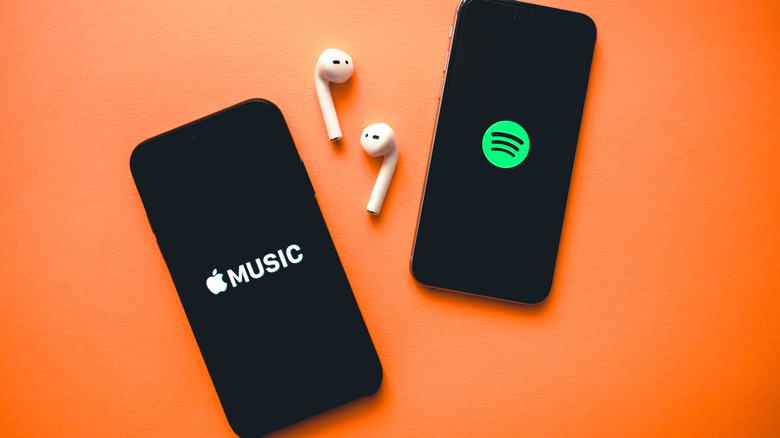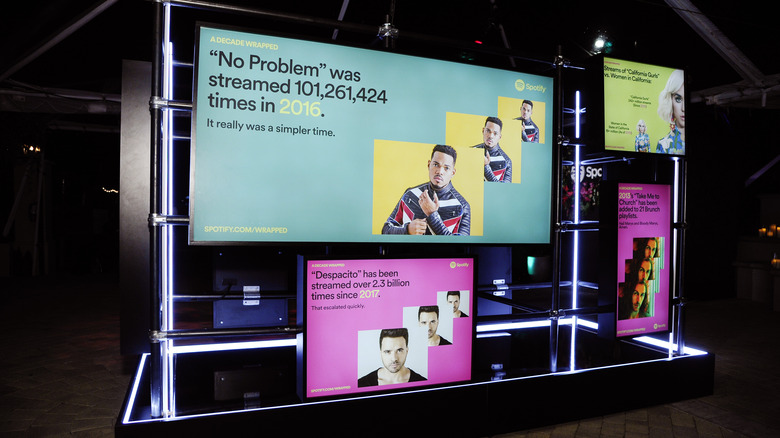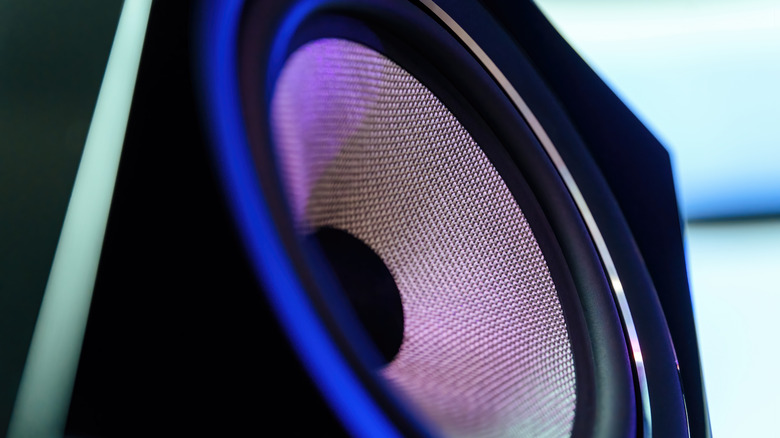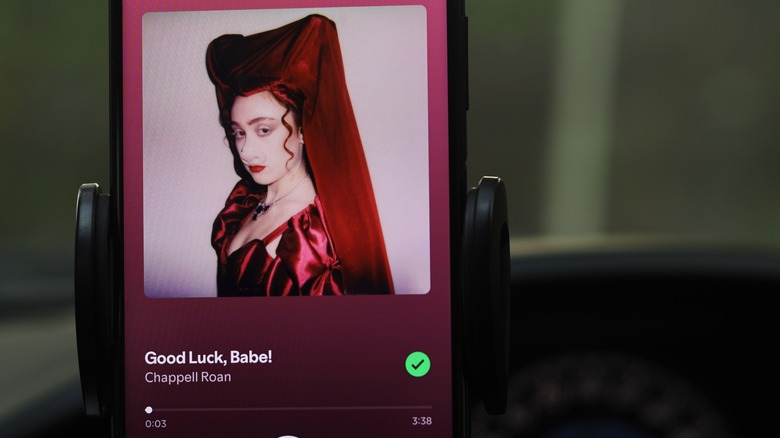Spotify Vs. Apple Music: Which Streaming Platform Is The Better Bang For Your Buck?
Spotify vs. Apple Music — a years-long rivalry that seems to whip people into a frenzy whenever Wrapped season comes along. If you're still on the fence and aren't sure who to declare your loyalty to, you don't need to worry. Both streaming services are actually incredibly similar, despite what some diehard users of each app would have you believe. Since they charge subscribers virtually the same amount of money each month, the deciding factors lie in the apps' special features.
Podcast lovers who want a social, hyper-personalized music streaming service will find a home at Spotify. For $10.99/month, you can access music, podcasts, and audiobooks, in addition to a plethora of playlists tailored to your specific tastes. For some, though, all of this is just overkill. They want a practical music service that prioritizes songs' sound quality over tryhard marketing tactics. That's where Apple Music comes in. It doesn't hurt that the individual plan costs a dollar less than Spotify each month, either. At the end of the day, it's all a matter of taste.
The prices are comparable
As mentioned previously, Apple Music and Spotify are pretty much equal when it comes to pricing. In addition to their individual plans, they offer plans for families and students, at $16.99 and $5.99, respectively. When it comes to families, up to six people are allowed on the plan. Each streaming service also offers special benefits for students. Apple Music subscribers get a free subscription to Apple TV+ for the duration of their academic careers. As for Spotify, users get access to Hulu, although with ads.
There are some variations, however. Spotify offers a free version of their app with ads, along with Duo plans for $14.99, perfect for couples who want to lower their monthly Spotify payments by splitting the price. While Apple Music doesn't offer Duo plans, it does offer Voice plans at $4.99, which is currently their cheapest available option and beats out Spotify. With the Voice plan, you can access Apple Music's catalog exclusively through Siri, making it ideal for people with visual impairments and casual listeners who don't want to be glued to their phone screens.
Spotify Wrapped still dominates
Spotify is constantly releasing new features to keep the app engaging, user-friendly, and hyper-personalized. Perhaps their most well-known feature is Spotify Wrapped, where they reveal the songs, artists, and genres you most enjoyed throughout the year. In fact, "Spotify Wrapped Day" has become something of a tradition on social media, with people sharing their Spotify Wrapped to their Instagram stories.
Meanwhile, Apple Music has struggled to keep up, even though Apple Music revealed its own version of Wrapped in 2019, called "Replay." After a couple of years of only releasing playlists, they added more to their year-in-review feature, showcasing your top artists and songs. People complained about the lack of easy shareability, however, in addition to the lack of fun, colorful visuals that make Wrapped so appealing. In comparison, Replay can seem plain and lackluster. It does function similarly to Spotify Wrapped, though Apple Music users' bitterness over Wrapped has become such a widespread meme that nobody else seems to acknowledge it.
Apple Music's audio quality is unparalleled
Its sound quality is perhaps the biggest advantage Apple Music has over Spotify. Music buffs praise its use of lossless audio, which lends its music the same quality as a CD. Spotify's audio files, on the other hand, are more compressed, compromising unmatched quality for easy access to its music selection.
Lossless audio isn't the only thing you'll get with Apple Music. This streaming service uses surround sound tech to provide spatial audio and an overall more immersive listening experience. There is a catch, though — you'll need to use a pair of Apple headphones to use this feature. AirPods Max, Pro, and 3 are all supported.
When it comes down to numbers, it looks like Apple Music still has Spotify beat. It can stream audio up to 24-bit/192kHz. If you already know what that means, then Apple Music is probably for you. For those who aren't in the know, "bit" is short for "bitrate," which is what audio quality is measured by. According to Gumlet, "Audio bitrate is the measure of bits (audio data) processed over a given period of time." kHz stands for kilohertz. The higher these two numbers, the better. Spotify, while still boasting an impressive sound quality themselves, still doesn't have lossless audio. While Spotify was supposed to release their "HiFi" feature back in 2021, it still has yet to be seen. In the meantime, Apple Music continues to dominate in terms of sound quality.
Podcasts or radio?
When it comes to this aspect of each app, it all comes down to personal preference. Spotify first introduced podcasts to its app in 2015, and people marveled at the bold move to incorporate multiple forms of content in one place. Apple Music's main pull is its vast music library, but keeps its podcasts relegated to a separate app. Apple Podcasts and Spotify are both loved by podcast listeners. While most use Spotify, people tend to download more episodes from Apple Podcasts, according to data released at the beginning of 2023. It's also free, unlike Spotify. Still, this doesn't change the fact that podcasts aren't incorporated into Apple Music's app. People who prefer a more streamlined experience might want to download Spotify instead.
Apple Music still offers a diverse array of audio content, though, even if Spotify has a hold on podcasts. In 2020, they released Apple Music Radio, which focuses on broadcasting live shows in a more traditional radio format, unlike their competitor. If you strongly prefer music over podcasts or vice versa, then you can download either Apple Music or Apple Podcasts. Still, if you're curious about radio, then you can dip your toe into Apple Music.
Spotify's social aspect
Spotify currently has Apple beat on this front. While Apple Music allows you to see your friends' playlists and what they've listened to in the past, Spotify allows you to follow along with your friends' song choices live. Spotify has also released new features in order to encourage a more social experience. In 2021, they released Blend, which allows multiple people to mix their music tastes together to create a unique, self-updating playlist. It also shows you how closely your tastes align. There's also Jam, a feature that lets users listen to the same playlist and add to the queue. People can share Jam links with each other, or, if someone is connected to a Bluetooth speaker and is on the same WiFi as their friends, people in the vicinity will be invited automatically.
However, Apple Music has been catching up. One of Spotify's social features, collaborative playlists, is no longer unique to the streaming service. As of 2023, Apple Music has begun to roll out its version of collaborative playlists, which shares much of the same features as Spotify's, in addition to a variety of reaction emojis you can use to react to the songs on the playlist.





